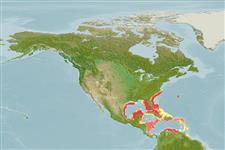>
Anguilliformes (Eels and morays) >
Ophichthidae (Snake eels) > Ophichthinae
Etymology: Apterichtus: From the Greek απτερόν (apteron), without fins, and ίχθύς (ichtus, more correctly written ichthys; masculine), fish..
More on author: Gilbert.
Environment: milieu / climate zone / depth range / distribution range
Ökologie
seewasser demersal; tiefenbereich 3 - 400 m (Ref. 4455), usually 30 - 80 m (Ref. 37039). Subtropical; 37°N - 8°N
Western Atlantic: North Carolina, USA and western Bahamas to Venezuela. Eastern Atlantic: only one specimen from St. Helena Island (Ref. 4455).
Length at first maturity / Size / Gewicht / Alter
Maturity: Lm 2.4, range 2 - 2.46 cm
Max length : 60.0 cm TL Männchen/unbestimmt; (Ref. 5288)
Wirbelzahl: 137 - 145. This species is distinguished by the following characters: tail 1.8-1.9, head 14-19, and body depth 53-67 in total length; preopercular pores 3 and pores in supratemporal canal 3; conical teeth, uniserial on jaws and vomer; vomerine teeth 5-7; body coloration nearly uniform pale yellow to tan, fresh specimens have a fine sprinkling of melanophores which can take on a mottled or freckled appearance; two brown blotches behind the eye surround a pale patch about equal to eye; and MVF 62-142, total vertebrae 137-145 (n=14) (Ref. 101270).
Burrows in the sand on the continental shelf (Ref. 4455).
Life cycle and mating behavior
Maturities | Fortpflanzung | Spawnings | Egg(s) | Fecundities | Larven
Robins, C.R. and G.C. Ray, 1986. A field guide to Atlantic coast fishes of North America. Houghton Mifflin Company, Boston, U.S.A. 354 p. (Ref. 7251)
IUCN Rote Liste Status (Ref. 130435)
Bedrohung für Menschen
Harmless
Nutzung durch Menschen
Tools
Warning: mysqli::__construct(): (08004/1040): Too many connections in /var/www/html/includes/speciessummary.lib.php on line 2104
Can't connect to MySQL database fbquizv2. Errorcode: Too many connections
